Breaking News


Popular News

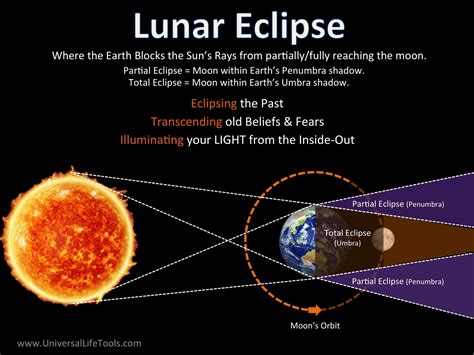
Learn about the different types of solar eclipses, including partial, annular, total, and hybrid. Also, find out how solar eclipses are predicted.Do you ever wonder about the different types of solar eclipses that can be observed? In this blog post, we will explore the fascinating world of solar eclipses and uncover the unique characteristics of partial, annular, total, and hybrid eclipses. From understanding the basics of solar eclipses to delving into the specifics of each type, we will take a comprehensive look at these natural phenomena. Additionally, we will discuss how astronomers predict solar eclipses and the tools they use to forecast these rare celestial events. Whether you’re a seasoned astronomer or simply curious about the wonders of the universe, this post will provide valuable insights into the various types of solar eclipses. So, sit back, relax, and prepare to embark on an educational journey through the enchanting world of solar eclipses.
Contents
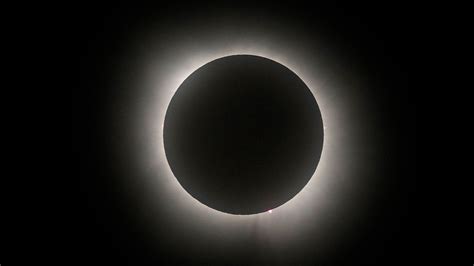
Solar eclipses occur when the moon passes between the sun and the Earth, blocking all or part of the sun’s light. This can only happen at new moon, when the sun and the moon are in conjunction as seen from the Earth. There are three main types of solar eclipses: total, partial, and annular. Solar eclipses are thrilling celestial events that occur when the sun, moon, and Earth are aligned in a straight line. They can only occur during a new moon, when the sun and moon are in conjunction as seen from the Earth.
In a total solar eclipse, the sun is completely blocked by the moon, leading to a period of total darkness in the path of the moon’s shadow. The sky becomes twilight-like and stars and planets become visible. During a partial solar eclipse, only part of the sun is covered by the moon, leading to a crescent-shaped sun. The rest of the sun appears as a bright crescent around the moon. An annular solar eclipse occurs when the moon is too far away from the Earth to completely cover the sun, leaving a ring of sunlight visible around the moon.
These types of solar eclipses are observed by astronomers and skywatchers all around the world, and they are an awe-inspiring sight to behold. The next solar eclipse is always eagerly anticipated, and many people travel long distances to experience this extraordinary phenomenon. Understanding the different types of solar eclipses and their unique characteristics can help you prepare for this incredible event and appreciate the mysteries of our universe.

A partial solar eclipse occurs when the Moon only partially obscures the Sun’s disk, resulting in a dramatic natural phenomenon where the Sun appears to have a dark shadow taking a bite out of it. This happens when the Sun, Moon, and Earth are not exactly lined up, and the Sun’s disk is only partly covered by the Moon. The result is a stunning display of the Sun’s crescent shape, with a small portion of the solar disk still visible.
During a partial solar eclipse, the sky darkens to a certain extent, creating an eerie and otherworldly atmosphere. People viewing the eclipse from the ground will experience a noticeable change in lighting, as well as a drop in temperature. The phenomenon is best observed using special solar viewing glasses or by creating a pinhole projector to safely view the eclipse without damaging the eyes.
It’s important to note that a partial solar eclipse should never be observed with the naked eye, as the Sun’s UV radiation can cause permanent damage to the eyes. Special precautions should always be taken to ensure safe viewing, and experts advise using proper equipment or following the guidance of experienced professionals to observe this incredible natural event.
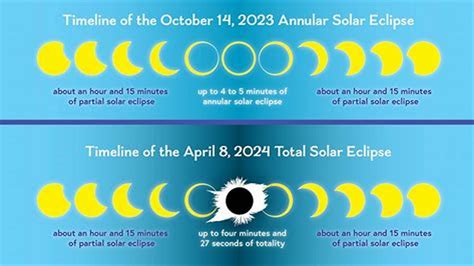
An annular solar eclipse occurs when the Moon covers the Sun’s center, leaving the Sun’s visible outer edges to form a “ring of fire” or annulus around the Moon. This happens when the Moon is near its apogee, the farthest point from Earth in its orbit, making it appear smaller in the sky. As a result, it does not completely block out the Sun’s light, creating the striking annular effect.
During an annular eclipse, viewers within the narrow path of the annularity will experience a surreal sight as the Sun transforms into a glowing ring in the sky. This celestial event offers a unique and mesmerizing spectacle for those lucky enough to witness it, as the ring-like appearance of the Sun provides a rare and captivating visual display.
While annular eclipses are certainly a remarkable sight, it’s important to observe them safely using proper eye protection to prevent any damage to your eyes. Remember to never look directly at the Sun without the use of certified solar viewing glasses or other safe viewing methods.
Like other types of solar eclipses, annular eclipses are a result of the delicate cosmic dance between the Sun, Moon, and Earth. These awe-inspiring celestial events serve as a powerful reminder of the beauty and wonder of the natural world, captivating observers and sparking a sense of curiosity and amazement.

Total Solar Eclipses
When total solar eclipses occur, the moon completely covers the sun, casting a shadow on the Earth. This is a rare and awe-inspiring event, as the sky goes dark and the sun’s corona becomes visible. The path of totality, where the total eclipse can be seen, is relatively narrow, often just a few dozen miles wide. Outside of this path, observers will see a partial eclipse, but only those within the path of totality will experience the full effect of the sun being completely blocked by the moon.
During a total solar eclipse, the temperature can drop significantly, and the sudden darkness can create an eerie atmosphere. Animals may behave strangely, and the sudden twilight can create a surreal experience for those lucky enough to witness it. Total solar eclipses occur somewhere on Earth approximately every 18 months, but the path of totality can vary, making it a rare event for any specific location.
| Advantages | Disadvantages |
|---|---|
| Creates a unique and unforgettable experience | Only visible in specific locations |
| Allows for scientific research and observation | Can cause disruptions in daily life due to sudden darkness |
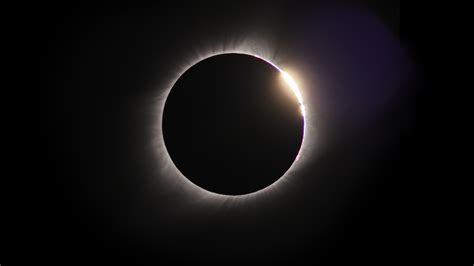
Hybrid solar eclipses are a rare type of eclipse that combine the characteristics of both total and annular eclipses. These unique events occur when the moon’s distance from the earth is in a state of transition, causing the eclipse to appear as annular in some locations and total in others. This phenomenon is a result of the curvature of the earth coming into play with the alignment of the sun, moon, and earth during the eclipse. The rarity of hybrid eclipses makes them a fascinating and sought-after event for astronomers and skywatchers around the world.
During a hybrid solar eclipse, the moon’s distance from the earth is at just the right point to create a unique viewing experience. In some locations along the eclipse’s path, the moon will appear to be at the perfect distance from the earth to completely block out the sun, resulting in a total eclipse. In other areas, the moon will be slightly farther from the earth, causing it to appear smaller and leaving a ring of sunlight visible around the edges, creating an annular eclipse. This variation in viewing experiences depending on location is what sets hybrid eclipses apart from other types of solar eclipses.
In order to view a hybrid solar eclipse, it’s important to be in the right place at the right time. Unlike total or annular eclipses, which can be seen from a larger area, hybrid eclipses have a smaller viewing window due to the specific alignment of the sun, moon, and earth. This makes witnessing a hybrid eclipse an especially rare and exciting event for those lucky enough to be in the path of totality.
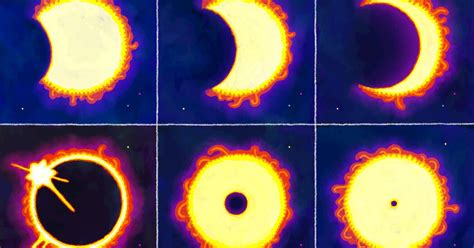
Types of Solar Eclipses
Solar eclipses are a fascinating natural phenomenon that have captivated humanity for centuries. These events occur when the moon passes between the sun and the Earth, casting its shadow on our planet. However, predicting when and where a solar eclipse will occur is no easy feat. The prediction of solar eclipses involves complex calculations and precise astronomical observations.
One method of predicting solar eclipses is to use astronomical tables and charts that track the movements of the sun, moon, and Earth. These tables can predict the occurrence of solar eclipses years in advance, allowing astronomers and enthusiasts to plan for and observe these rare events. Additionally, computer models and simulations have become valuable tools in the prediction of solar eclipses, allowing for even greater accuracy and precision in determining when and where these events will take place.
In addition to these scientific methods, there are also cultural and historical methods for predicting solar eclipses. Ancient civilizations such as the Babylonians and the Mayans developed their own systems for predicting celestial events, including solar eclipses. By studying the movements of the sun, moon, and stars, these early astronomers were able to anticipate the occurrence of solar eclipses with a surprising degree of accuracy.
In conclusion, the prediction of solar eclipses is a fascinating blend of science, mathematics, and cultural tradition. By combining advanced astronomical techniques with ancient knowledge and historical observations, astronomers are able to accurately forecast when and where these breathtaking events will occur. Whether using modern computer models or ancient astronomical tables, predicting solar eclipses continues to be a captivating and awe-inspiring pursuit.
A solar eclipse occurs when the Moon passes between the Earth and the Sun, partially or fully blocking the Sun’s light.
What are the types of solar eclipses?
There are three main types of solar eclipses: total, partial, and annular.
What is a total solar eclipse?
A total solar eclipse occurs when the Moon completely covers the Sun, causing the Sun’s outer atmosphere to become visible.
What is a partial solar eclipse?
A partial solar eclipse occurs when the Moon only partially covers the Sun, creating a crescent shape of sunlight.
What is an annular solar eclipse?
An annular solar eclipse occurs when the Moon is farthest from the Earth and does not block the entire Sun, leaving a ring of sunlight visible around the Moon.
How often do solar eclipses occur?
Solar eclipses are relatively rare and can occur up to 5 times a year, but they are only visible from specific locations on Earth.
How can I safely view a solar eclipse?
It’s important to use proper eye protection, such as special eclipse glasses or a solar viewer, to safely view a solar eclipse and avoid damaging your eyes.